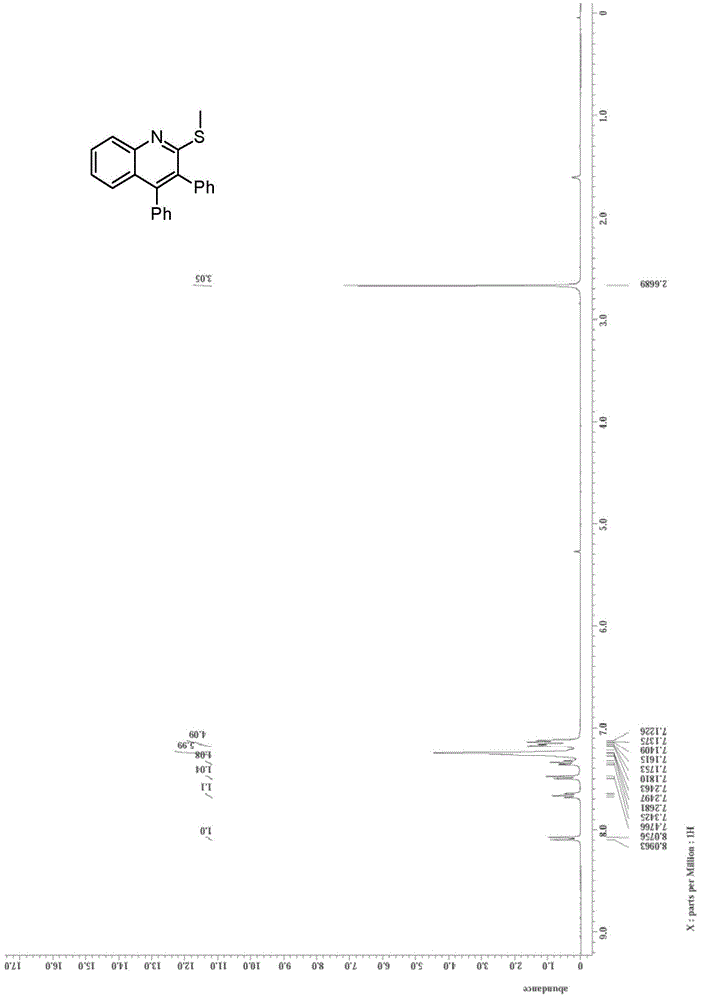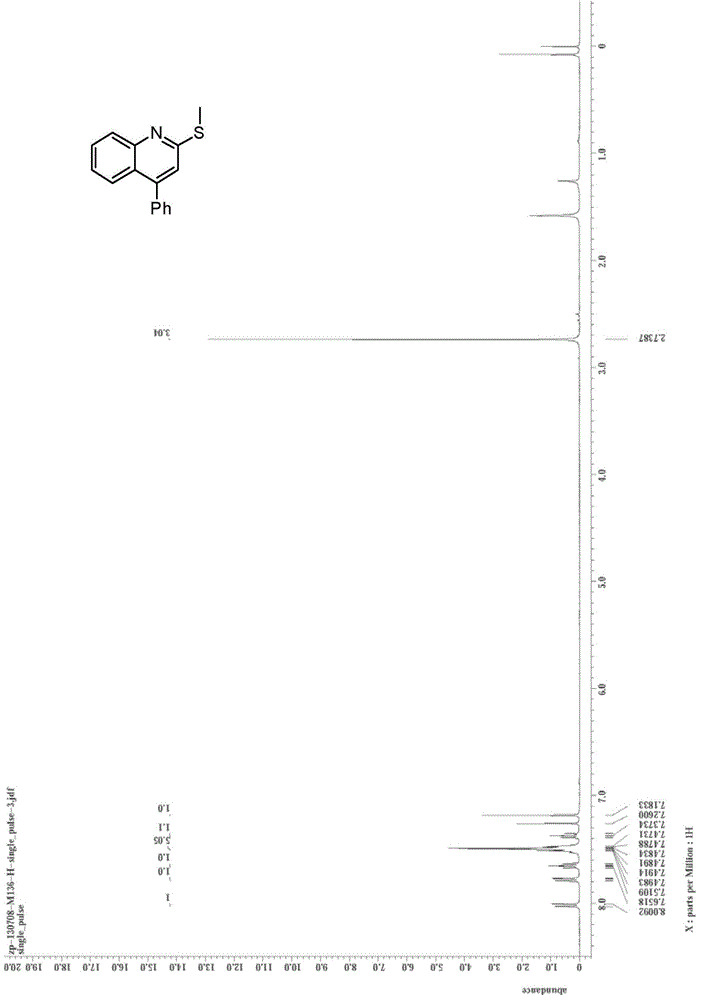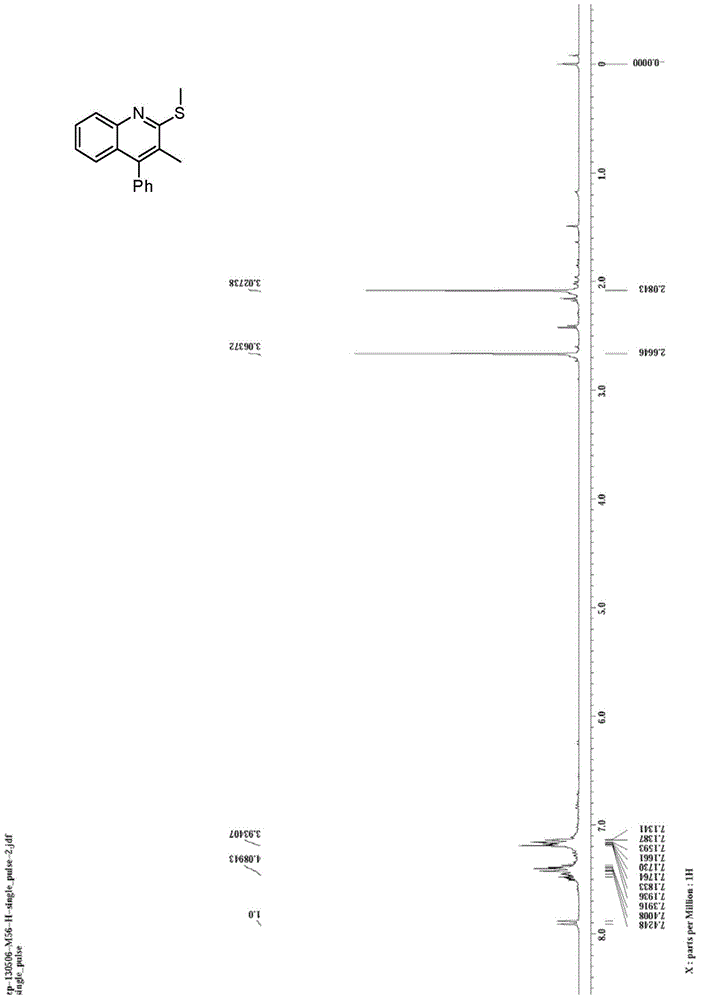Method for preparing 2-alkylthioquinoline derivatives
A technology for alkylthioquinoline and derivatives, which is applied in the field of preparing 2-alkylthioquinoline derivatives, can solve the problems of low yield of 2-alkylthioquinoline derivatives and the like, and achieves easy purification and synthesis of products. High rate, scientific and reasonable synthesis method
- Summary
- Abstract
- Description
- Claims
- Application Information
AI Technical Summary
Problems solved by technology
Method used
Image
Examples
Embodiment 1
[0038] Embodiment one, 2-methylthio-3,4-diphenyl-quinoline (R in structural formula I 1 =R 2 = phenyl, R = hydrogen, R 3 = methyl)
[0039] In the reactor of 25mL, add successively compound phenylisothiocyanate (0.75mmol, 90 μ L) shown in formula II, compound tolan (0.5mmol, 89mg) shown in formula III, methyl trifluoromethanesulfonate ( 1.5mmol, 172μL), and finally add 1.5mL of dichloroethane as a solvent, seal the reactor, and react at 130°C for 12h. After the reaction system was cooled, 15 mL of water and 15 mL of dichloromethane were added and stirred for 30 min, then extracted three times with 15 mL of dichloromethane, and the organic phases were combined. The organic phase was washed with saturated brine, and finally dried over anhydrous magnesium sulfate for 0.5 h. After filtration, the organic phase was rotary evaporated to obtain a crude product. The crude product was separated by column chromatography with petroleum ether: ether: triethylamine = 200:5:0.5 (volume ...
Embodiment 2
[0044] Embodiment two, 2-methylthio-4-phenyl-quinoline (R in structural formula I 1 = Hydrogen, R 2 = phenyl, R = hydrogen, R 3 = methyl)
[0045] Into a 25 mL reactor, phenylisothiocyanate (0.75 mmol, 90 μL), phenylacetylene (0.5 mmol, 55 μL), methyl trifluoromethanesulfonate (1.5 mmol, 172 μL) were sequentially added, and finally 1.5 mL of di Ethyl chloride was used as a solvent, the reactor was sealed, and reacted at 130°C for 12h. After the reaction system was cooled, 15 mL of water and 15 mL of dichloromethane were added and stirred for 30 min, then extracted three times with 15 mL of dichloromethane, and the organic phases were combined. The organic phase was washed with saturated brine, and finally dried over anhydrous magnesium sulfate for 0.5 h. After filtration, the organic phase was rotary evaporated to obtain a crude product. The crude product was separated by column chromatography with petroleum ether: ether: triethylamine=200:5:0.5 (volume ratio) as the eluen...
Embodiment 3
[0050] Embodiment three, 2-methylthio-3-methyl-4-phenyl-quinoline (R in structural formula I 1 = methyl, R 2 = phenyl, R = hydrogen, R 3 = methyl)
[0051] To a 25mL reactor, add phenylisothiocyanate (0.75mmol, 90μL), 1-phenyl-1-propyne (0.5mmol, 68μL), methyl trifluoromethanesulfonate (1.5mmol, 172μL) in sequence ), and finally add 1.5mL dichloroethane as a solvent, seal the reactor, and react at 130°C for 12h. After the reaction system was cooled, 15 mL of water and 15 mL of dichloromethane were added and stirred for 30 min, then extracted three times with 15 mL of dichloromethane, and the organic phases were combined. The organic phase was washed with saturated brine, and finally dried over anhydrous magnesium sulfate for 0.5 h. After filtration, the organic phase was rotary evaporated to obtain a crude product. The crude product was separated by column chromatography with petroleum ether: ether: triethylamine=200:5:0.5 (volume ratio) as the eluent and 200-300 mesh sili...
PUM
 Login to View More
Login to View More Abstract
Description
Claims
Application Information
 Login to View More
Login to View More - R&D
- Intellectual Property
- Life Sciences
- Materials
- Tech Scout
- Unparalleled Data Quality
- Higher Quality Content
- 60% Fewer Hallucinations
Browse by: Latest US Patents, China's latest patents, Technical Efficacy Thesaurus, Application Domain, Technology Topic, Popular Technical Reports.
© 2025 PatSnap. All rights reserved.Legal|Privacy policy|Modern Slavery Act Transparency Statement|Sitemap|About US| Contact US: help@patsnap.com



